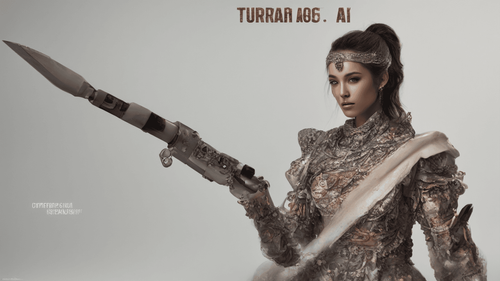
Introduction: The Creative Potential of AI
In a world where technology continues to push the boundaries of innovation, AI is emerging as an unexpected artist, turning mere words into breathtaking works of art. The fusion of artificial intelligence and artistic expression has led to a mesmerizing phenomenon – the transformation of text into stunning visual masterpieces. Welcome to the realm where algorithms become brushes and data evolves into art; welcome to the world of AI-generated art.
AI Turn Words into Art: Unveiling the Magic
The Artistic Algorithm: How AI Transforms Words into Visuals
AI, powered by complex algorithms and neural networks, possesses the capability to decipher the intricate meanings behind words and phrases, and translate them into visual representations. By analyzing patterns, sentiments, and contexts, AI can create art that captures the essence of language in a visual form. It's the embodiment of creativity meeting computational precision.
The Canvas of Code: Understanding AI-Generated Artistry
AI-generated art is a symphony of code and creativity. These algorithms interpret words, phrases, or even entire passages and translate them into diverse art forms – from abstract paintings reminiscent of Picasso's brushstrokes to intricate digital designs that could rival the works of renowned graphic artists. The canvas becomes a playground for AI, showcasing its ability to transform data into captivating visual narratives.
AI's Artistic Toolkit: Techniques for Text-to-Art Conversion
Several techniques empower AI to turn words into visual wonders:
- Style Transfer: AI can infuse artworks with the style of famous artists, giving birth to unique pieces that merge textual concepts with artistic flair.
- Generative Adversarial Networks (GANs): These networks pit AI against itself, resulting in the creation of art that blurs the lines between human-made and AI-generated.
- Neural Style Transfer: By separating content from style, AI can merge text-based content with the aesthetic essence of art, producing stunning compositions.
AI Turn Words into Art: Applications and Implications
The convergence of AI and art opens new doors of possibility:
- Digital Storytelling: AI-generated art can enhance the visual appeal of digital storytelling, amplifying the impact of narratives through captivating visuals.
- Marketing Marvels: Brands can utilize AI-generated art to create eye-catching marketing campaigns that resonate with audiences on a deeper level.
- Personalized Creations: AI can craft personalized art pieces based on individual preferences, transforming ordinary gifts into heartfelt expressions.
AI Turn Words into Art: A Glimpse into the Future
The Evolution of AI Creativity: What Lies Ahead?
As AI continues to evolve, so does its creative prowess. The future holds exciting possibilities, from AI-powered art galleries featuring immersive experiences to collaborations between human artists and AI, resulting in unprecedented art forms that transcend traditional boundaries.
The Ethical Palette: Navigating the Moral Landscape
With great power comes great responsibility. The rise of AI-generated art raises ethical questions about authorship, originality, and the essence of human creativity. Striking a balance between technological innovation and ethical considerations will shape the trajectory of AI in the art world.
FAQs: Decoding AI and Artistic Transformation
Can AI genuinely emulate human creativity in art? AI can replicate certain aspects of human creativity by analyzing vast amounts of data and generating novel combinations. However, the intrinsic emotional depth and intuition of human artists remain distinct.
What role does data play in AI-generated art? Data serves as the foundation for AI-generated art. The algorithms learn from vast datasets, extracting patterns and concepts that inform the artistic output.
Is AI-generated art considered "real" art? The definition of art is subjective. While AI-generated art showcases creativity and skill, debates continue regarding its authenticity and the role of human intervention.
Can AI-generated art inspire emotions in the same way traditional art does? AI-generated art can evoke emotions, but the depth of emotional connection may differ from traditional art forms. The personal narrative of human artists adds a layer of resonance that AI might not replicate.
How can AI-generated art influence the traditional art landscape? AI-generated art challenges conventional notions of creativity and authorship. It prompts discussions about the nature of art, innovation, and the evolving role of artists.
What safeguards are in place to prevent misuse of AI-generated art? The responsible deployment of AI-generated art involves establishing ethical guidelines, copyright considerations, and transparent disclosure of the AI's involvement in the creative process.
Conclusion: The Artistic Symphony of AI
In a world driven by innovation, the fusion of AI and art showcases the remarkable capabilities of technology to redefine creativity. AI turns words into art, weaving a tapestry where language and visuals harmonize in ways that captivate and challenge our perceptions. As AI continues to reshape artistic landscapes, it invites us to question, appreciate, and embrace the boundless potential of the creative mind – whether human, algorithmic, or a mesmerizing blend of both.
Explore the breathtaking realm of AI-generated art – where imagination transcends boundaries and words become a canvas for innovation. Welcome to the future, where pixels dance to the tune of algorithms and AI whispers poetry through brushstrokes of code. Welcome to a world where AI turns words into art, redefining the way we experience and appreciate the boundless wonders of human ingenuity and technological advancement.